| 书目名称 | Demographic Aspects of Migration | | 编辑 | Thomas Salzmann,Barry Edmonston,James Raymer | | 视频video | http://file.papertrans.cn/266/265285/265285.mp4 | | 概述 | Motives, Explanations and Consequences | | 丛书名称 | Demografischer Wandel - Hintergründe und Herausforderungen | | 图书封面 |  | | 描述 | Dr. Albert Schmid President of the Federal Office for Migration and Refugees According to the United Nations, about 200 million people of the estimated world population of 6.8 billion are international migrants – that corresponds to about three per cent of the total world population. The proportion of international migrants in the global population has increased only marginally in the last 40 years. But, as a result of global population growth, the absolute number of migrants has increased, and their structure and spatial distribution has changed considerably. A structural shift has taken place primarily in the industrialised countries, where less than 20 per cent of the global workers are now living, but where more than 60 per cent of all migrants worldwide reside. Since 1990, more than 16 million people have moved to Germany, while about 11 million have left the country in the same period. Altogether, 15 million people of international migration origin are living in Germany, comprising almost 19 per cent of Germany’s current population of 82 million. At the end of 2006, about 64 million people out of Europe’s population of 732 million, or nine per cent, lived in a European countr | | 出版日期 | Book 2010 | | 关键词 | Demographic Processes; Demographic behaviour; Nation; employment; fertility; immigration; international mi | | 版次 | 1 | | doi | https://doi.org/10.1007/978-3-531-92563-9 | | isbn_softcover | 978-3-531-16541-7 | | isbn_ebook | 978-3-531-92563-9 | | copyright | VS Verlag für Sozialwissenschaften | Springer Fachmedien Wiesbaden GmbH, Wiesbaden 2010 |
The information of publication is updating

|
|
 |Archiver|手机版|小黑屋|
派博传思国际
( 京公网安备110108008328)
GMT+8, 2025-11-15 10:37
|Archiver|手机版|小黑屋|
派博传思国际
( 京公网安备110108008328)
GMT+8, 2025-11-15 10:37


